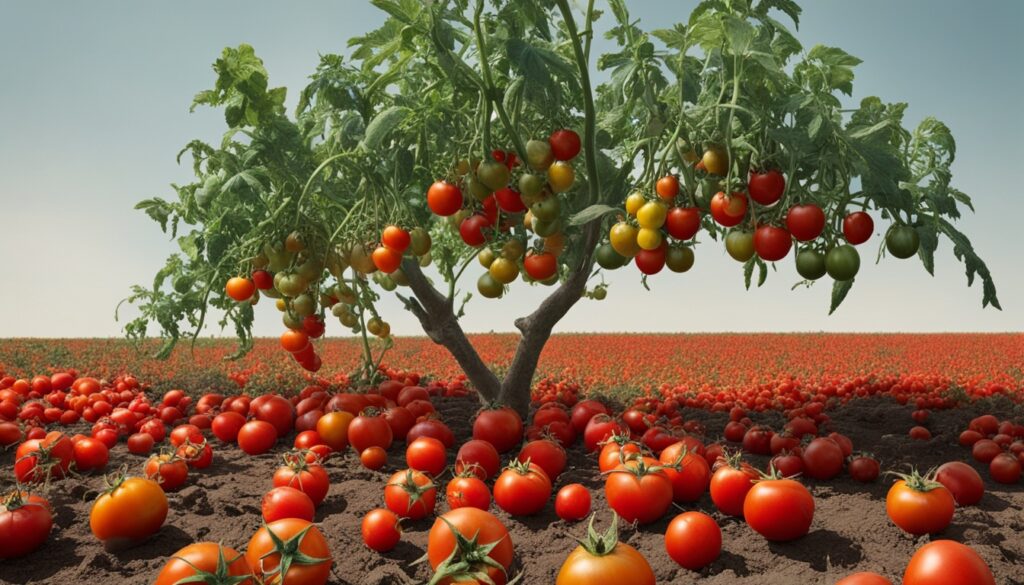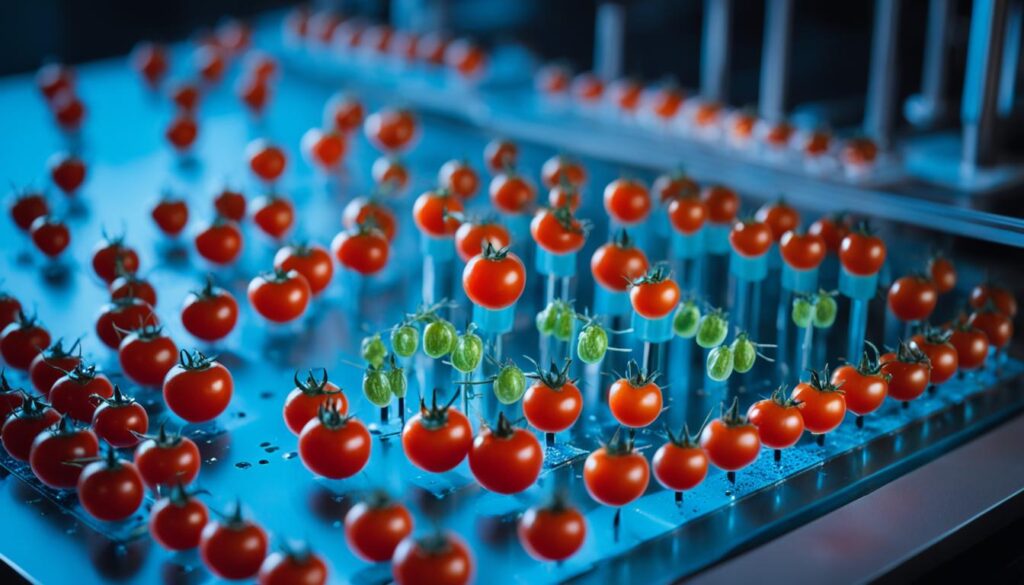Key Takeaways
- Genetic research unlocks the biochemical and molecular bases of tomato flavor and nutrition.
- Omics technologies, including genomics, transcriptomics, and metabolomics, enable the identification of key pathways, enzymes, and genes involved in volatile compound biosynthesis.
- Insights into tomato domestication and evolution provide valuable genetic resources for breeding improved varieties.
- Modulating transcription factors like SlLOB1 can enhance shelf life without compromising flavor or nutrition.
- Exploring the genetic diversity of wild and semi-wild tomato populations holds great potential for developing even better-tasting, more sustainable tomatoes.
Tomatoes have over 400 smells called volatile organic compounds (VOCs). About 25 to 30 of these give tomatoes their special taste. This shows how complex the science behind tomato flavor is. Scientists are learning to make tomatoes taste better and be more nutritious by studying tomato genes.
Scientists use many tools to understand tomato flavor. These include molecular biology, genetics, and omics technologies. They also use machine learning and gene editing. They aim to find out how to make tomatoes with the perfect flavor.
This involves looking at the compounds that make tomatoes taste good. Also, they study how these compounds are made. The goal is to create the ultimate tomato.
The Importance of Flavor and Quality
Flavor and quality drive fruit sales in the US. Yet, many people aren’t happy with the taste of modern tomatoes. Even though tomatoes are big, red, and resistant to sickness, they lack flavor.
Many things have mixed up the taste of tomatoes. These include how genes work, where tomatoes grow, and the cost of studying them. Also, big farms often care more about how many tomatoes they can grow than how good they taste.
Poor Flavor in Modern Tomato Varieties
Breeding tomatoes for certain looks and qualities has made them less tasty. This happened because making tomatoes better in one way can make them worse in taste. It’s tricky to get both good looks and flavor in tomatoes.
Consumer Dissatisfaction with Lack of Flavor
People want tomatoes that taste better than they do now. But making them look good and resist diseases has made their taste suffer. For example, the relationship between tomato size and sugar could be better understood.
And because we focused on outside traits, some elements that could enhance taste got lost. These include things that make the tomato’s flavor better. So, the tomatoes we get are not as flavorful as we’d like.
Understanding Biochemical Bases for Good Flavor
Tomato taste comes from sugars, acids, and special compounds. More than 400 compounds are in tomatoes, but only a few are key for taste. We must know more about these important flavor parts to make tomatoes taste better.
Flavor Components in Tomatoes
Tomatoes’s unique taste comes from a mix of sugars, acids, and volatile organic compounds (VOCs). Sugars like glucose and fructose add sweetness. Acids like citrate, malate, and ascorbate give a bit of sourness. Around 25 to 30 out of over 400 VOCs are key to tomato flavor.
Role of Sugars, Acids, and Volatile Organic Compounds
Studies show VOCs make up 62% of tomato sweetness, more than sugars. VOCs come from nutrients like carotenoids and amino acids. These include branched-chain amino acid (BCAA)-derived, phenylalanine-derived, carotenoid-derived, and fatty acid-derived volatiles.
Volatile Organic Compounds Contributing to Flavor
Researchers aim to find the genes that make those important VOCs in tomatoes. Knowing this helps make tomatoes taste better. It’s key to growing tasty tomatoes that people love.
| Flavor Component | Contribution to Tomato Sweetness |
|---|---|
| Volatile Organic Compounds (VOCs) | 62% |
| Sugars (Glucose, Fructose) | 29% |
Genetic Research on Tomatoes
Studying tomato genes has helped us understand how they make volatile organic compounds (VOCs). We can see what makes each tomato unique using tools like genomes, transcriptomes, and metabolomes. This area of study is very active because there’s still a lot we don’t know about how tomatoes create their smells.
Utilization of Genomics, Transcriptomics, and Metabolomics
Having tomato reference genomes is critical for learning about tomato genetics. It also helps us understand the chemicals that give tomatoes their taste and smell.
With the help of genomics, transcriptomics, and metabolomics, we can find differences in tomatoes and understand the roles of different genes.
Identification of Genetic Variation and Gene Functions
Advanced tools like omics are key in studying tomato genes and proteins. There’s still much to learn about how tomatoes produce their distinctive smells. But, by using a lot of data, scientists are getting closer to solving this puzzle.
Branched-Chain Amino Acid-Derived Volatiles
The branched-chain amino acid (BCAA)-derived volatiles greatly add to tomato taste. They are part of what makes tomatoes smell good. These compounds are made in similar ways both in tomatoes and in tiny living things.
Biosynthetic Pathways of BCAA-Derived Volatiles
When tomatoes ripen, they use BCAAs like leucine and isoleucine to breathe. These BCAAs don’t directly make nice smells. First, they change into α-ketoacids.
This change happens in several steps. Soon after, these α-ketoacids become the nice, fruity smells we love. They become volatile aldehydes, α-hydroxyacids, and other BCAA-derived volatiles.
Enzymes and Genes Involved in Regulation
People are studying hard to learn about the biosynthetic pathways. They are looking for the enzymes and genes that tell these pathways what to do. BCAA transaminases play a big part in making odor compounds in fruits like melons. In apples, there’s also a special way, the “citramalate pathway,” to make smells.
Genetic Research on Tomatoes: Unlocking Flavor & Nutrition
Transcription Factor SlLOB1 and Fruit Softening
Recent research found a key player in tomato softening: the transcription factor SlLOB1.
Its job is to manage genes linked to softening without changing ripeness, taste, or nutrients.
Stopping SlLOB1 makes tomatoes stay firm longer. Boosting SlLOB1 speeds up softening. This insight is great news for farmers. They can now keep fruits fresh longer.
thanks to a study. And it won’t make the tomatoes less tasty.
Modulating SlLOB1 for Improved Shelf Life
Changing SlLOB1 could make ripe tomatoes last longer, keeping their yummy taste.
This change could make tomatoes last longer and be better for you.
They might have more healthy stuff, like antioxidants. This new finding shows how powerful genetic studies are.
are. They can help make tomatoes tastier, firmer, and longer lasting. People love tomatoes more when they are top quality.
Tomato Domestication and Evolution

New studies have discovered how small wild tomatoes grew into our big ones today.
This happened in two ways. One was in Ecuador, and the other was in Mesoamerica, now Mexico. While we used to think a tomato called Solanum pimpinellifolium was the first, we know it might not be.
Another type, Solanum lycopersicum cerasiforme, changed into big tomatoes in Ecuador about 76,000 years ago. Then, the type we all know spread from Mesoamerica to the world.
Two Domestication Paths: Ecuador and Mesoamerica
What’s cool is that tomatoes got smaller on their way to Mesoamerica. Then, people made them big again. This tells us a lot about how plants have changed over time because of farming. It also shows us what people might have liked in their tomatoes long ago.
Dedomestication and Redomestication Steps
The times tomatoes got small and then big again while moving to Mesoamerica are really important. They show the complex story of this plant. By knowing this history, we can make new tomatoes that taste better and are healthier and help our planet more.
Insights into Early Cultures and Crop Evolution
Learning about tomato history teaches us about new plants and ancient cultures. This information is very useful. It helps us find natural traits that these old societies liked but lost. Adding these lost traits back could help make great, eco-friendly tomatoes for the future.
Breeding for Better Tomatoes
Scientists look at the tomato’s past to understand how plants evolved over time. This knowledge helps them see how to make crops better for the future. They study wild and semi-wild tomato plants to find great traits. These traits could make tomatoes tastier, sizable, and more resistant to sickness and bugs.
Then, they plan to mix these good traits with today’s tomatoes. This mix could help farmers grow better tomatoes with less effort.
Evaluating Wild Populations for Desirable Traits
Wild tomatoes offer many different traits that are uncommon in today’s tomatoes. Scientists note that modern tomato plants only have a small part of the wild kinds. This makes the wild tomato varieties very important.
In California, there’s a place called the Tomato Genetics Resource Center. It holds many wild tomato species. Also, a large group of tomatoes has different traits due to breeding. This group helps make tomatoes taste better, grow bigger, and fight diseases.
Improving Flavor, Weight, and Disease Resistance
Researchers study the genetics of wild tomato varieties to improve today’s tomatoes. With new technology, they understand what makes tomatoes big, tasty, and unique. This knowledge helps plant new tomatoes that taste better, are bigger, and can fight off sickness.
Ultimately, this work aims to give people better and safer tomatoes to eat.
Omics Tools in Flavor Research

Studies mix genetic, sensory, chemical, and metabolomic research to guess the sweetness and liking in tomatoes using omics. They suggest upping some good smells (desirable VOCs) while lowering the bad tastes to make tomatoes taste much better.
They use genomics, transcriptomics, proteomics, and metabolomics to find genetic changes. They also predict what genes do and understand how to make tasty molecules. This helps make tomatoes that taste better and are healthier.
Predicting Sweetness and Overall Liking
Mixing sugars, acids, and smells (VOCs) is key to tomato taste. Studies prove omics tools are great at guessing how sweet and tasty tomato types are. This is key in breeding to make tomatoes taste better.
Identifying Desirable and Undesirable Compounds
Scientists use flavor research, tasting, and high-tech tools to pick the best and worst tomato tastes. Knowing this helps in breeding to up the good smells and cut the bad ones. This leads to tomatoes that taste great.
| Compound | Contribution to Flavor |
|---|---|
| Desirable VOCs | Increase levels to improve tomato flavor |
| Undesirable Compounds | Decrease levels to enhance tomato flavor |
Conclusion
Genetic research on tomatoes has moved forward a lot. It has helped us understand how good flavor and nutrition are linked to genes. Tools like genomics have let us see the important roles of certain compounds in tomato taste. Now, we know how to make tomatoes taste better and last longer.
The more we look at wild and semi-wild tomatoes, the more possibilities we find.
Thanks to places like the Tomato Genetics Resource Center and the Botanical Garden, we have many different tomato genes to work with. This means we can create new tomato types that are tastier and kinder to the environment.
Many mutant tomatoes are also useful for studying how they change over time.
Thanks to efforts, we have about 13,000 groups of tomato plants to study. These plants have differences that can teach us a lot about improving tomatoes today. With new wild tomatoes still being found, we’re just starting to see how much we can do.
FAQ about Genetic Research on Tomatoes
What is the importance of flavor and quality in tomatoes?
Flavor and quality matter a lot when we choose fruits in the US. Sadly, many modern tomatoes don’t taste good, which upsets people. To make better tomatoes, we need to know about sugars, acids, and VOCs.
What are the key components that contribute to tomato flavor?
A tomato’s special taste comes from sugars, acids, and VOCs. It has sugars like glucose and fructose. The most common acids are citrate, malate, and ascorbate. About 25–30 of over 400 VOCs really impact a tomato’s taste.
How have genetic research and omics tools helped in understanding tomato flavor?
Scientists are learning more about tomato VOCs thanks to genetic studies. They use tools to study the genome, transcriptome, and more. This helps find out how genes control tomato smells.
What role do branched-chain amino acid-derived volatiles play in tomato flavor?
BCAA-derived VOCs are key in making tomatoes taste good. They don’t directly make key flavors but help in the ripening process. Researchers are still looking into how to control the production of these VOCs.
How has the genetic research on tomato domestication and evolution provided insights for crop improvement?
Research shows that the tomatoes we have today came from wild ones. Understanding this history can help make tastier and more sustainable tomatoes. It shows us future paths for tomato breeding.
How are omics tools being used in tomato flavor research?
By combining different studies, we can use tools to guess how sweet and good a tomato is. These methods suggest changing VOC levels to make tomatoes taste much better.
